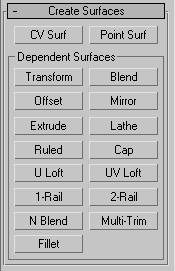Surface sub-objects are either independent point and CV surfaces (like the top-level point and CV surfaces described in Point Surface and CV Surface), or they are dependent surfaces. Dependent surfaces are surface sub-objects whose geometry depends on other surfaces or curves in the NURBS model. When you change the geometry of the original, parent surface or curve, the dependent surface changes as well.
You create surface sub-objects using the Create Surfaces rollout on the Modify panel for a NURBS surface, or using the NURBS toolbox.

Creation operations for dependent sub-objects require that you select one or more parent objects. In general, you can click and drag, or click and then click again. You can also use the H keyboard shortcut to open a Pick Object version of the Selection Floater for choosing the parent. (The Keyboard Shortcut Override Toggle must be on for H to work this way.)
Toolbox Buttons for Creating Surfaces
These are the toolbox buttons for creating surface sub-objects:
 Create an independent CV surface sub-object.
Create an independent CV surface sub-object.
 Create an independent point surface sub-object.
Create an independent point surface sub-object.
 Create a dependent transform surface.
Create a dependent transform surface.
 Create a dependent blend surface.
Create a dependent blend surface.
Create a dependent offset surface.
 Create a dependent mirror surface.
Create a dependent mirror surface.
 Create a dependent extrude surface.
Create a dependent extrude surface.
 Create a dependent lathe surface.
Create a dependent lathe surface.
 Create a dependent ruled surface.
Create a dependent ruled surface.
 Create a dependent cap surface.
Create a dependent cap surface.
 Create a dependent U loft surface.
Create a dependent U loft surface.
 Create a dependent UV loft surface.
Create a dependent UV loft surface.
 Create a dependent 1-rail sweep surface.
Create a dependent 1-rail sweep surface.
 Create a dependent 2-rail sweep surface.
Create a dependent 2-rail sweep surface.
 Create a dependent multisided blend surface.
Create a dependent multisided blend surface.
 Create a dependent multicurve trimmed surface.
Create a dependent multicurve trimmed surface.
 Create a dependent fillet surface.
Create a dependent fillet surface.
CV surface sub-objects are similar to object-level CV surfaces.
Point surface sub-objects are similar to object-level point surfaces. The points are constrained to lie on the surface.
A transform surface is a copy of the original surface with a different position, rotation, or scale.
A blend surface connects one surface to another, blending the curvature of the parent surfaces to create a smooth surface between them. You can also blend from a surface to a curve, or from a curve to a curve.
An Offset surface is offset a specified distance from the original along the parent surface's normals.
A mirror surface is a mirror image of the original surface.
An extrude surface is extruded from a curve sub-object. It is similar to a surface created with the Extrude modifier. The advantage is that an extrude sub-object is part of the NURBS model, so you can use it to construct other curve and surface sub-objects.
A lathe surface is generated from a curve sub-object. It is similar to a surface created with the Lathe modifier. The advantage is that a lathe sub-object is part of the NURBS model, so you can use it to construct other curve and surface sub-objects.
A ruled surface is generated from two curve sub-objects. It lets you use curves to design the two opposite borders of a surface.
This command creates a surface that caps a closed curve or the edge of a closed surface. Caps are especially useful with extruded surfaces.
A U loft surface interpolates a surface across multiple curve sub-objects. The curves become U-axis contours of the surface.
A UV loft surface is similar to a U loft surface, but has a set of curves in the V dimension as well as in the U dimension. This can give you finer control over the lofted shape, and require fewer curves to achieve the result you want.
Sweep surfaces are constructed from curves. A 1-rail sweep surface uses at least two curves. One curve, the "rail," defines one edge of the surface. The other curves define the surface's cross sections.
Sweep surfaces are constructed from curves. A 2-rail sweep surface uses at least three curves. Two curves, the "rails," define the two edges of the surface. The other curves define the surface's cross sections. A 2-rail sweep surface is similar to a 1-rail sweep. The additional rail gives you more control over the shape of the surface.
A multisided blend surface "fills in" the edges defined by three or four other curve or surface sub-objects. Unlike a regular, two-sided blend surface, the curves’ or surfaces’ edges must form a closed loop; that is, they must completely surround the opening that the multisided blend will cover.
A multicurve trimmed surface is an existing surface trimmed by multiple curves that form a loop.
A fillet surface is a rounded corner connecting the edges of two other surfaces.